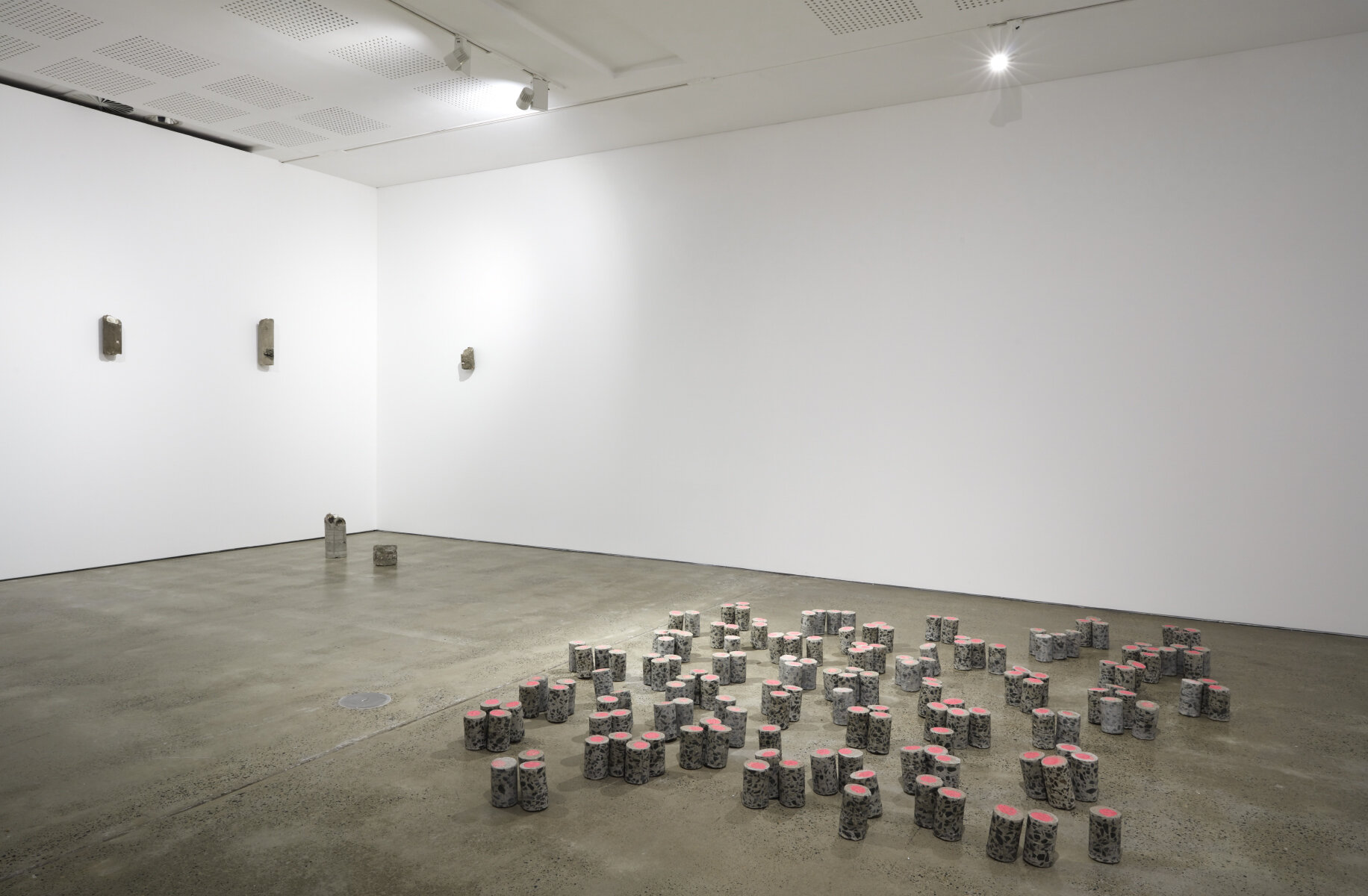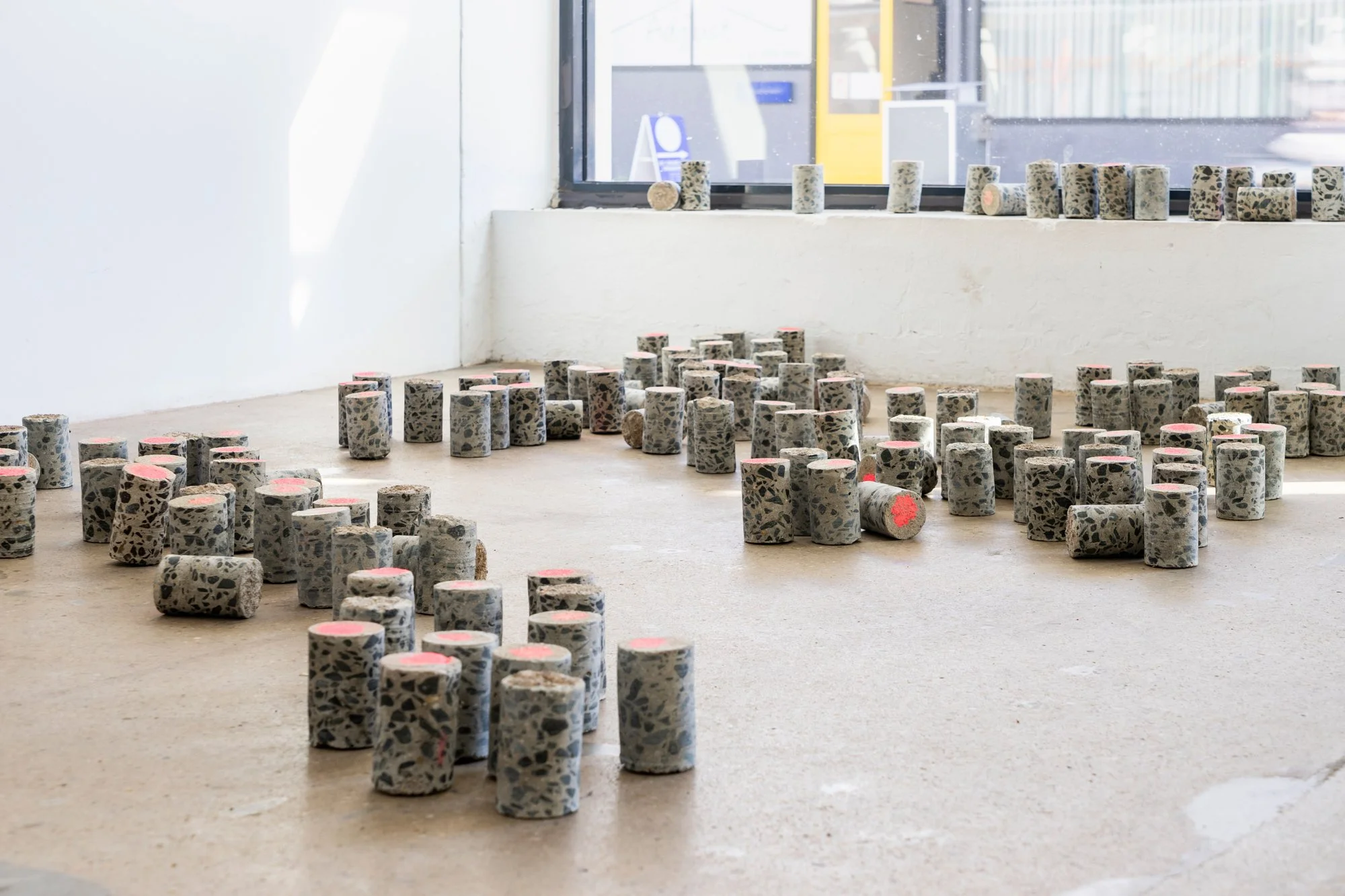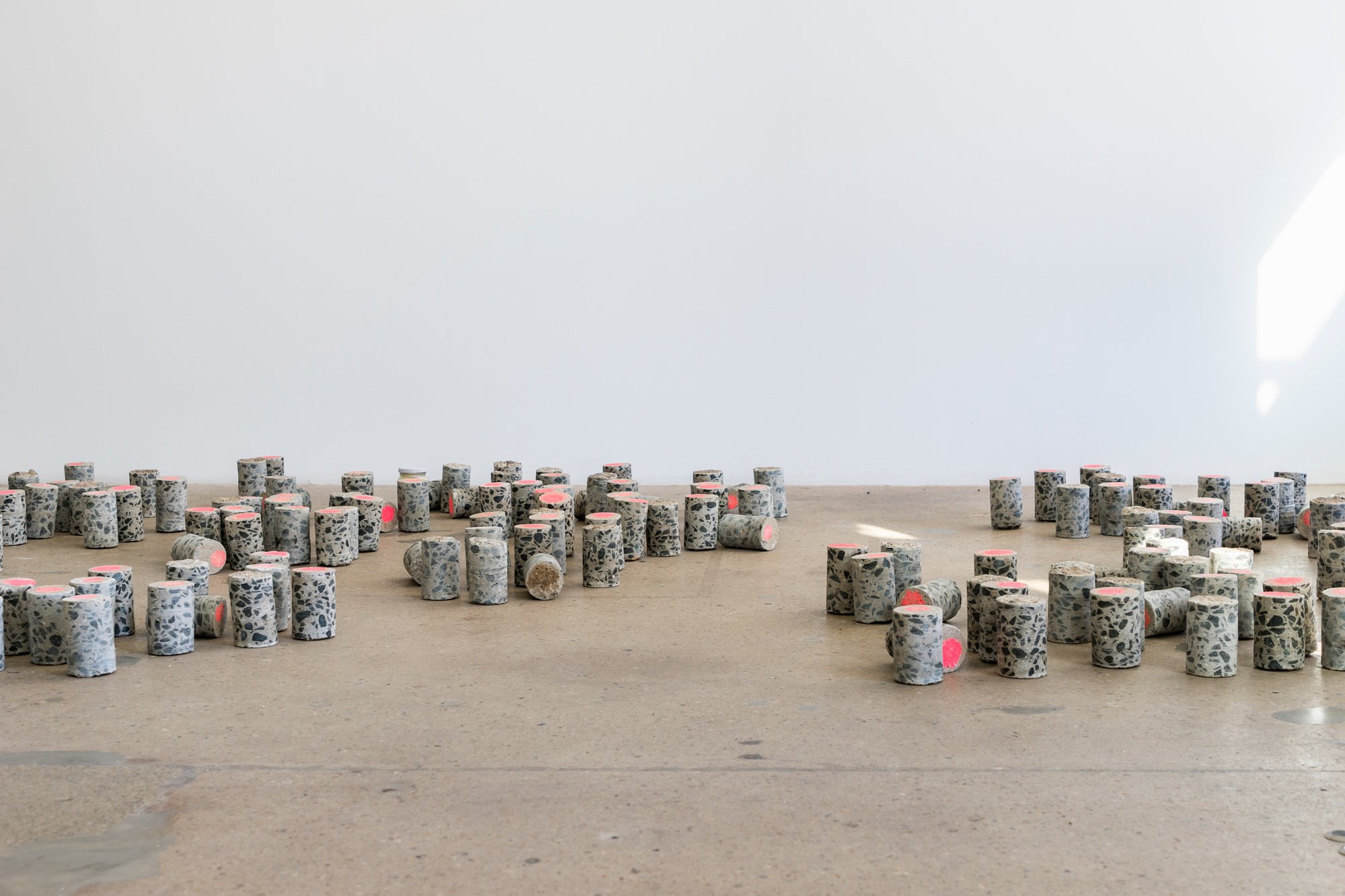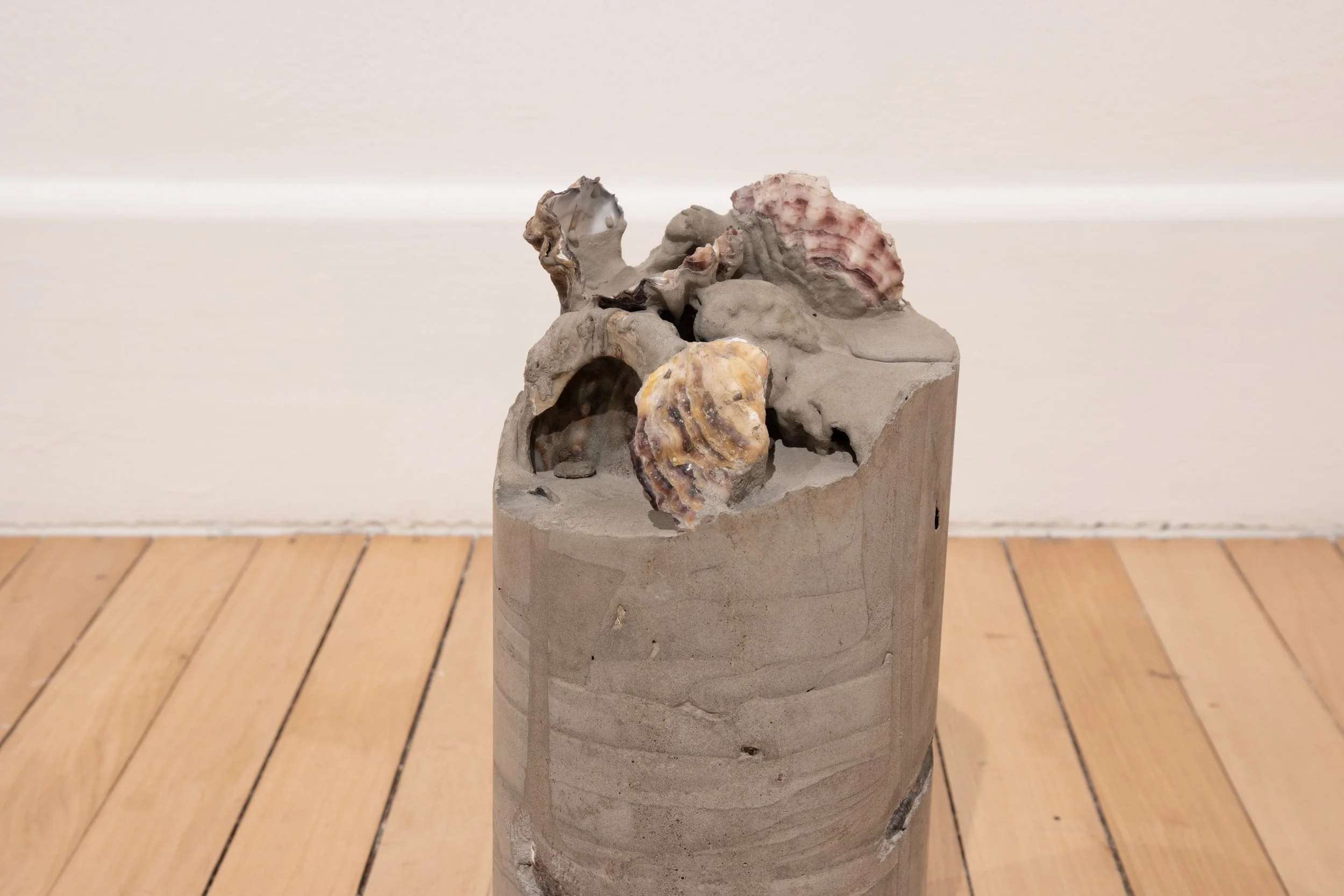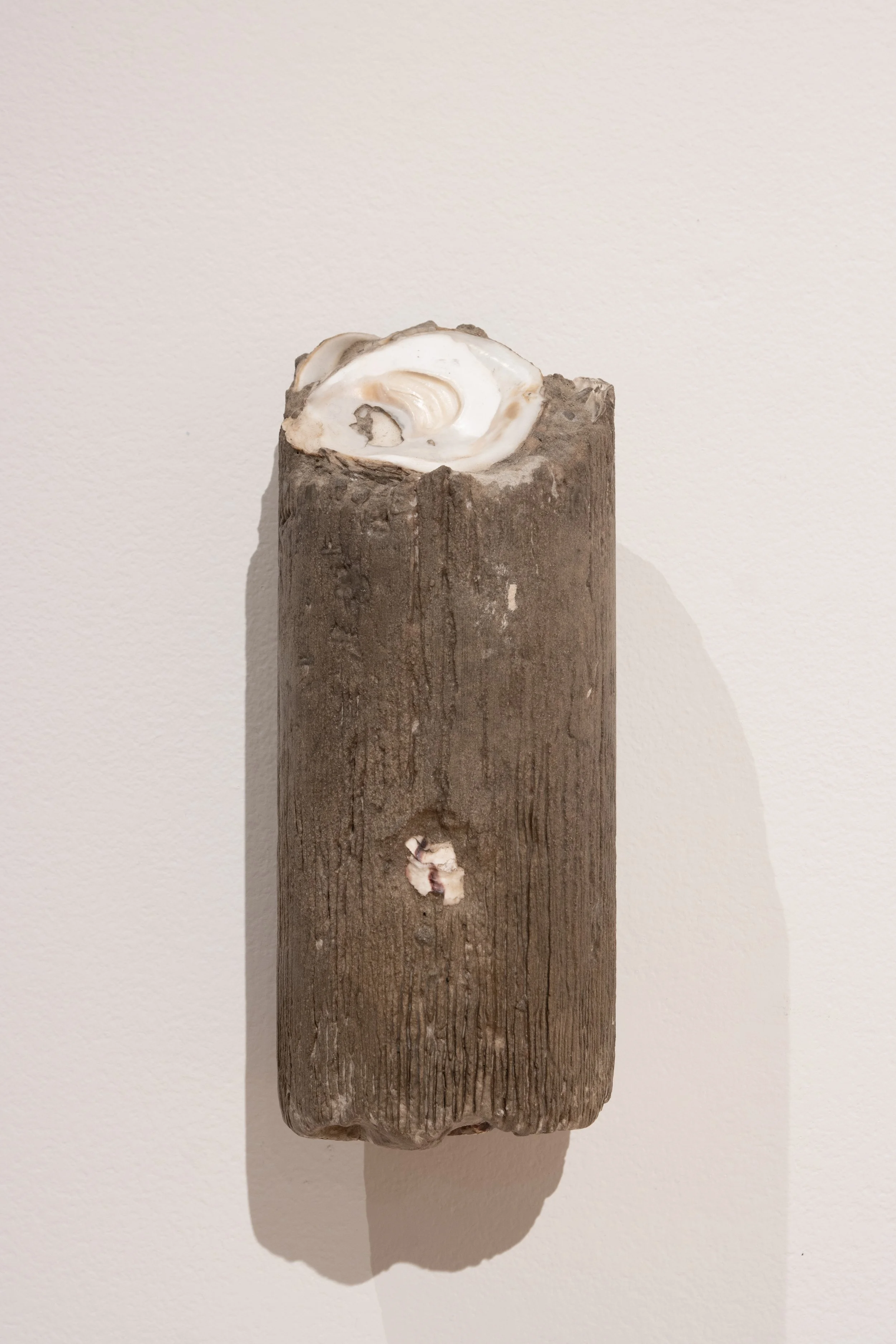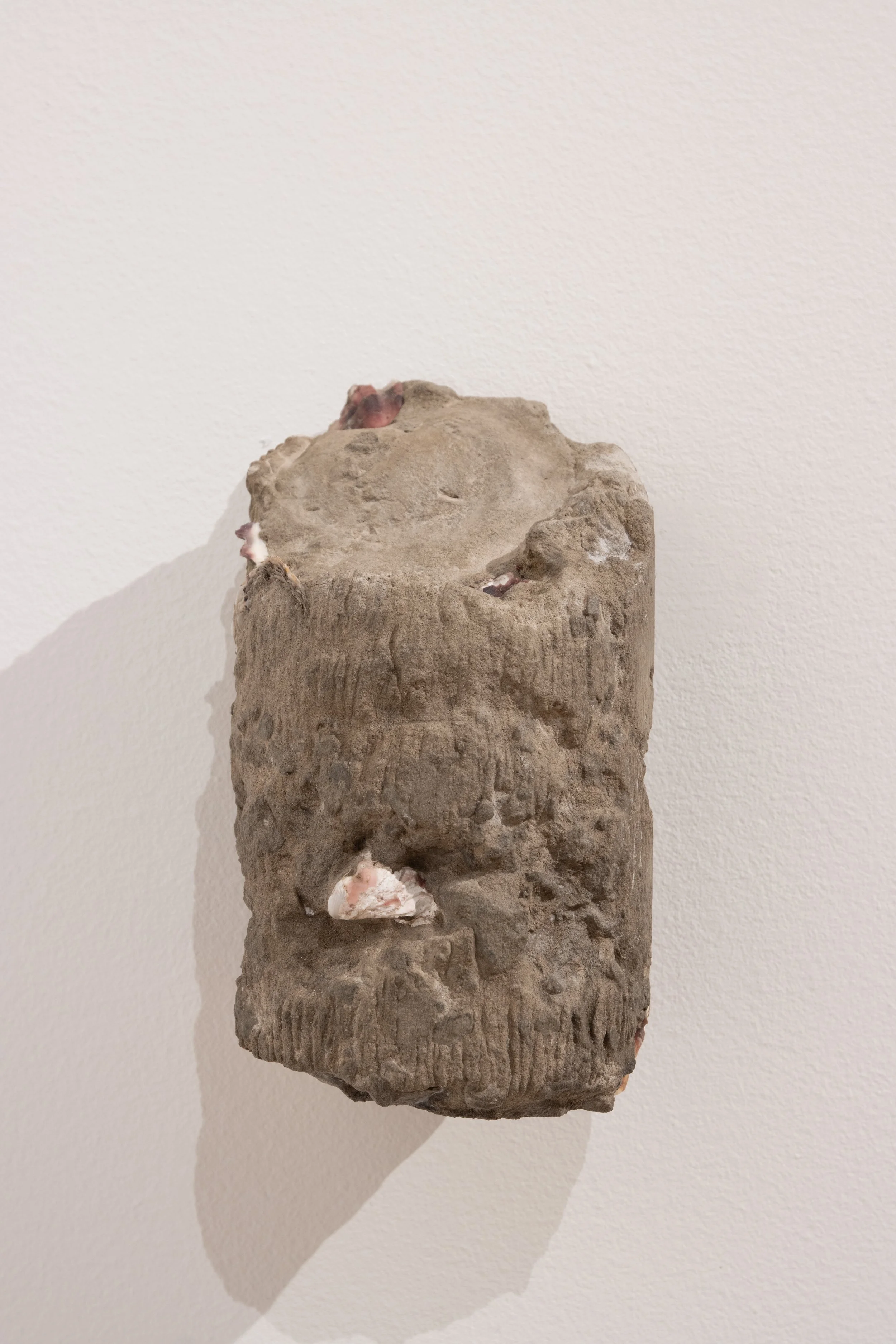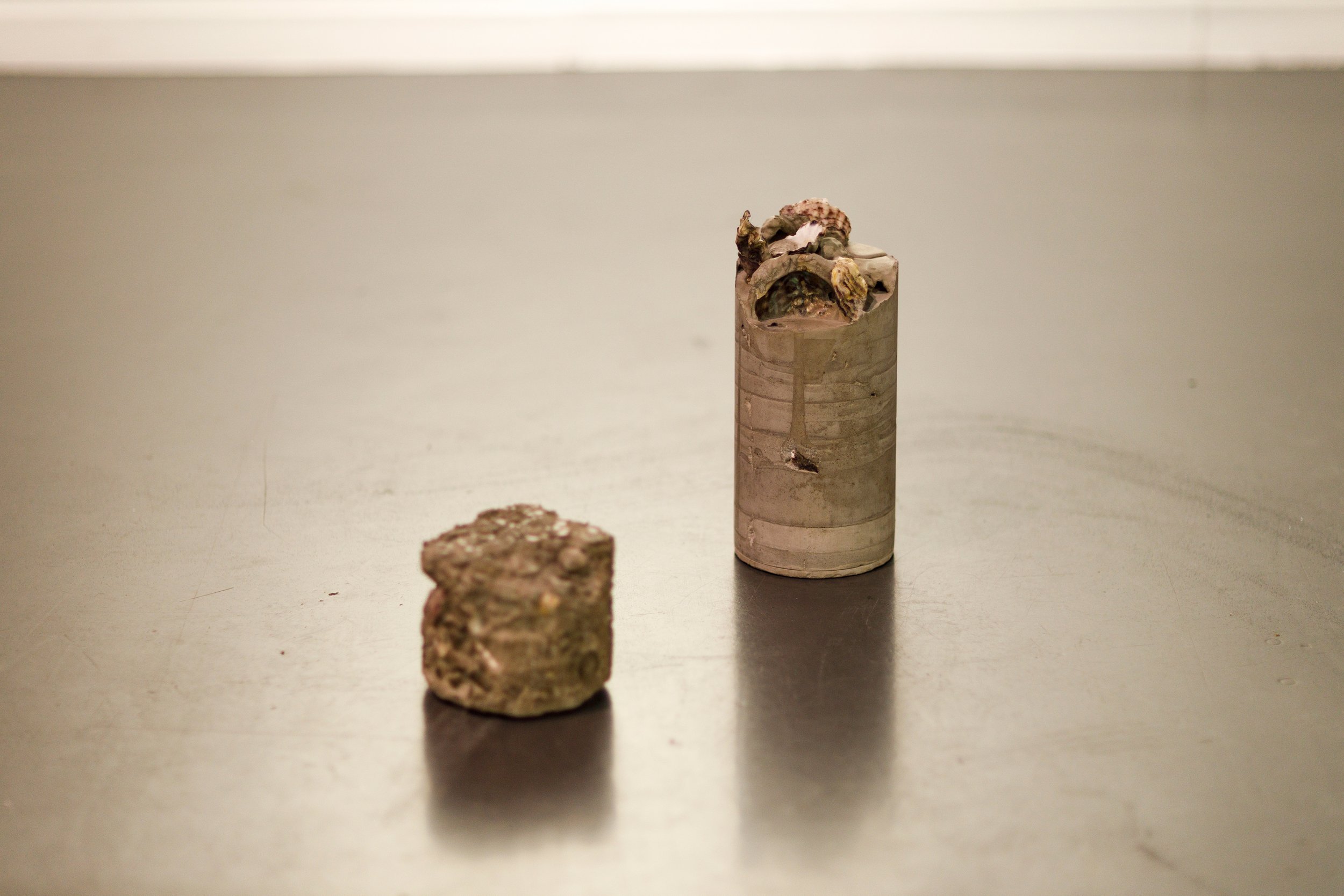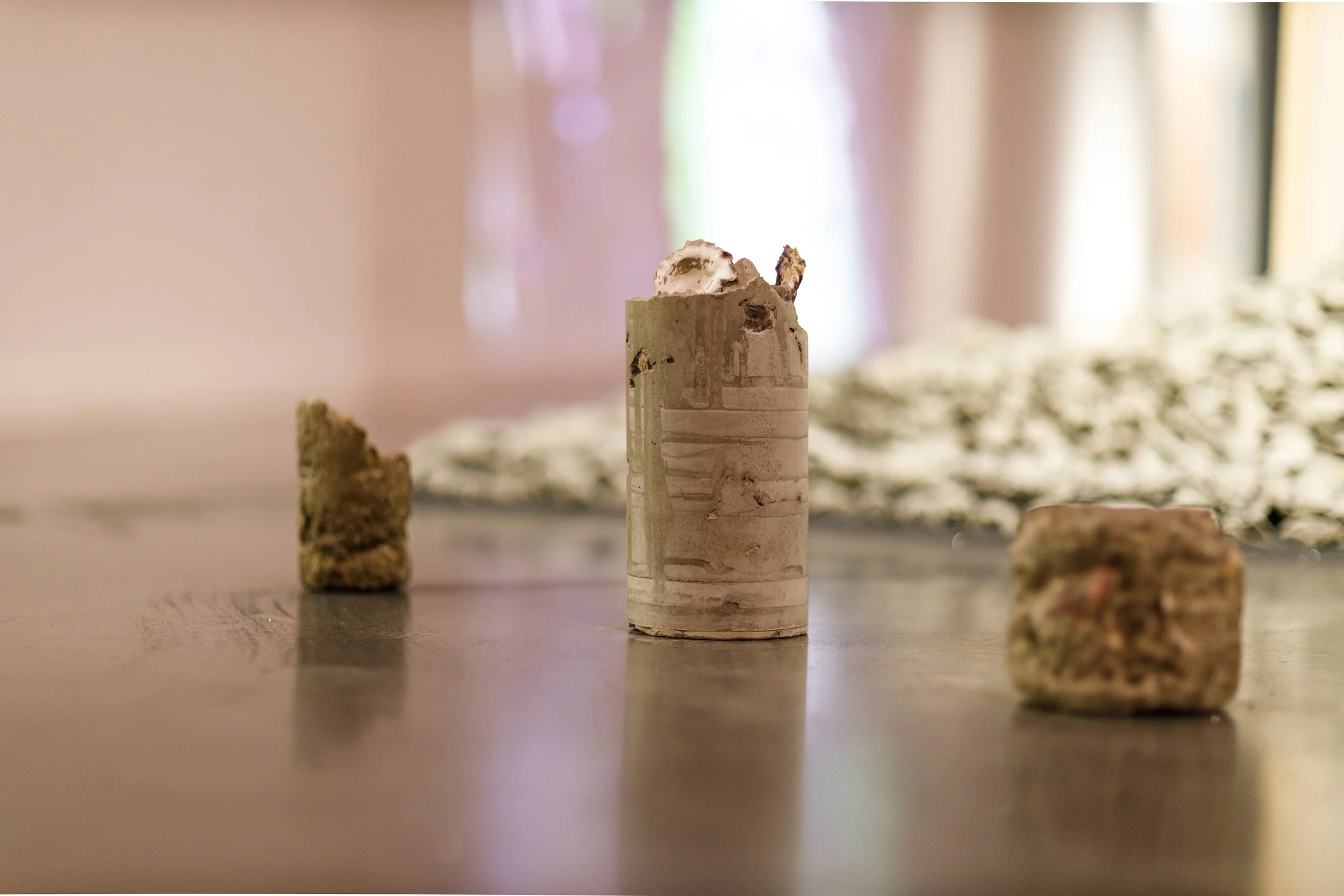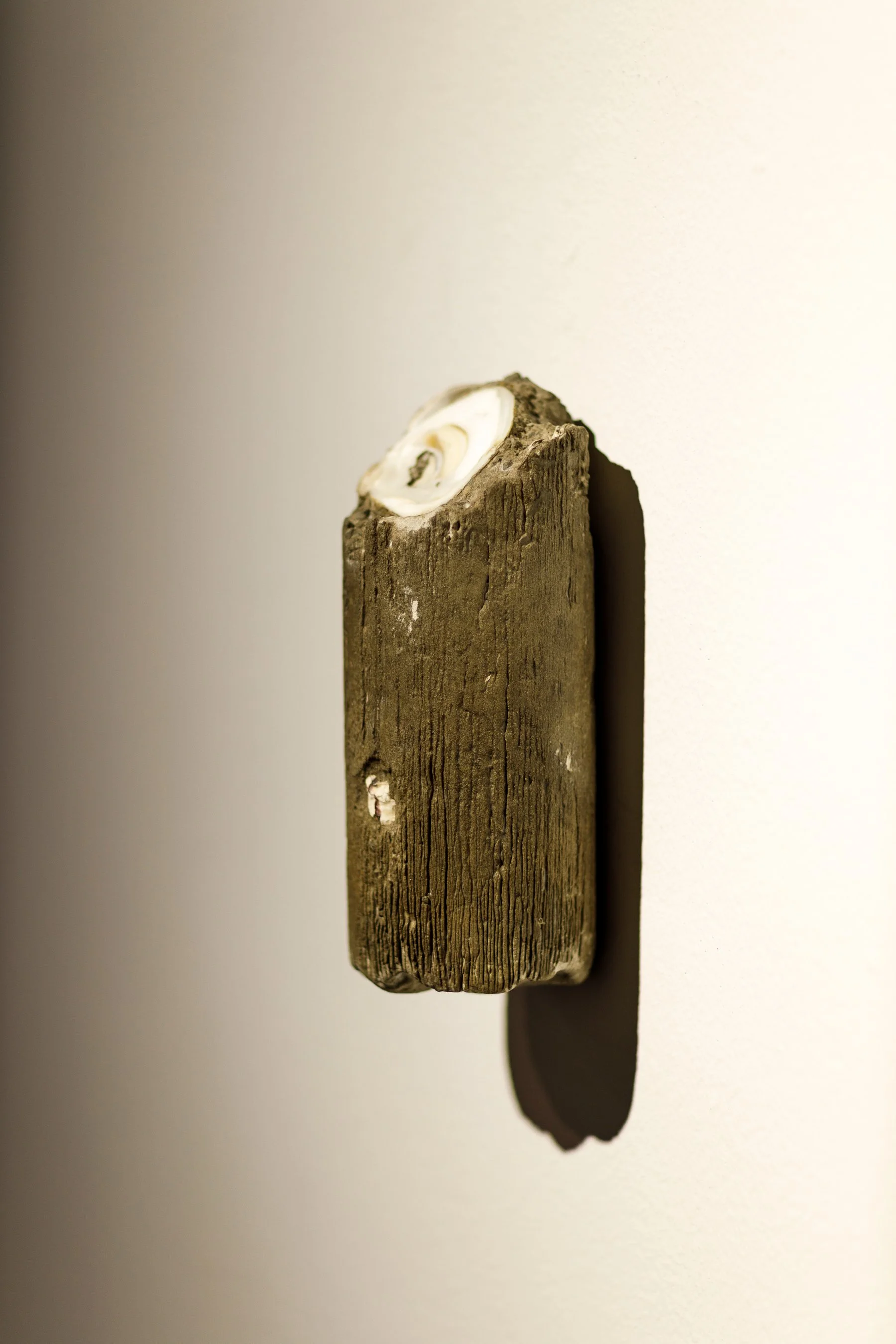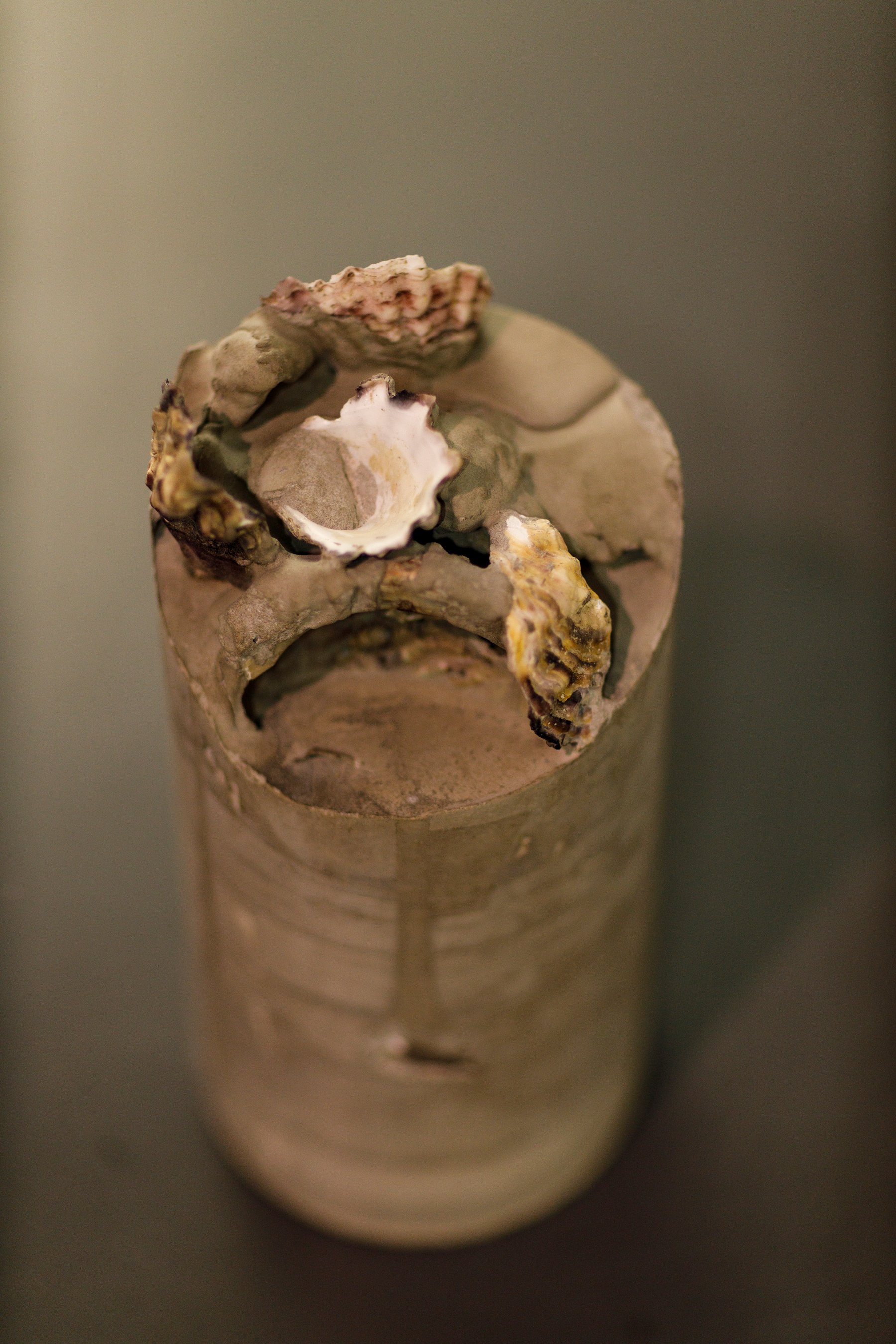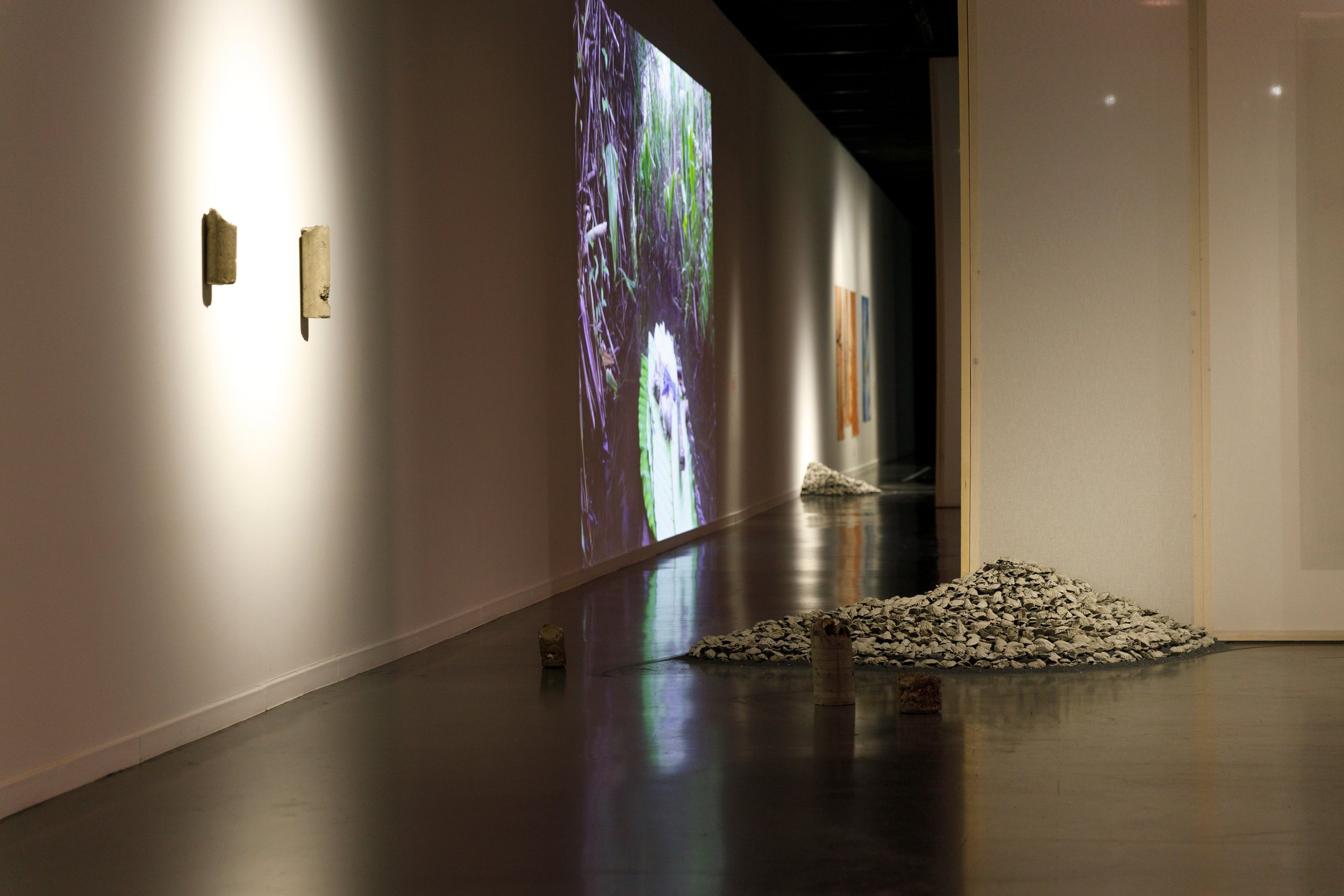Untitled (Extractions l)
2020
Core drilled Cement plug, aggregate, pink acrylic spray paint, beeswax
214 pieces - 70mm x 110mm
Courtesy of the Artist and Milani Gallery, Brisbane.
Photograph by Zan Wimberley
Untitled (Extractions I)
Untitled (Extractions l) is part of a series that is both in practice and theory connected to the reimagining of industrial materials such as concrete.
Cope has been researching and creating works that trace the economics and origins of the lime burning industry in Australia and how this everyday material has devastated Aboriginal shell middens and oyster reefs in Quandamooka Country as well as the wider coastal regions throughout Australia.
These plugs of concrete were extracted out of a cement pathway in Canberra on Ngunnawal Country. Cope was keen to make a work where she could perforate the concrete to highlight the toxic relationship we have with cement and its role in rendering the earth infertile.
Changing the direction and speed into larger creeks and rivers, and also preventing water to seep into natural depressions and water tables. The work spelled the word WALANGALA - meaning Long Water in the artists native tongue Jandai.
The cluster of multiple singular concrete plugs which made the base for WALANGALA become a new work, reminiscent of frog or fish eggs that the artist remembers from spending time in fresh water and connecting further with the grass country of the swamps and marsh lands which are always at risk from extractive industries and capitalism.
EXHIBITION HISTORY
- With Nature, Canberra Contemporary Artspace, 10 February – Saturday 6 April 2024
- Megan Cope: Fractures and Frequencies; UNSW Galleries; 16 January - 17 April 2021
Presented in association with Sydney Festival.
- IT’S ONLY A GIFT (IF YOU SEE IT AS A GIFT); OUTERSPACE Galleries, 6 October — 30 October 2021.
Megan Cope, Renato Antinao, Georgia Morgan, Shan Turner-Carroll & Elliot Bastianon.
Curated by Laurie Oxenford and Grace Dewar.
PRESS
https://www.outerspacebrisbane.org/program/its-only-a-gift-if-you-see-it-as-a-gift
Fractures and Frequencies; UNSW Galleries. Photographs by Zan Wimberley.
IT’S ONLY A GIFT (IF YOU SEE IT AS A GIFT); Outerspace Galleries. Photographs by Louis Lim
Untitled (Extractions Il)
2020
Concrete, pacific oyster shells, abalone shell. D
imensions variable
Courtesy of the Artist and Milani Gallery
Photography by Zan Wimberley
Untitled (Extractions II)
Untitled (Extractions ll) is part of a series that is both in practice and theory connected to the reimagining of industrial materials such as concrete.
Cope has been researching and creating works that trace the economics and origins of the lime burning industry in Australia and how this everyday material has devastated Aboriginal shell middens and oyster reefs in Quandamooka Country as well as the wider coastal regions throughout Australia.
This iteration of material composition stands as broken pillars or structural forms that the colonial establishment required in order to attain its grip on the Sovereign lands of Aboriginal peoples. The pillars, a metaphor of the stubborn stain that persists in the great forgetting of time and events that build the settler colonial imagination and its physical manifestations.
EXHIBITION HISTORY
- Te Au: Liquid Constituencies, Govett-Brewster Art Gallery, New Plymouth, Aotearoa New Zealand; 3 December, 2022 - 20 March 2023.
- Megan Cope: Fractures and Frequencies; UNSW Galleries; 16 January - 17 April 2021
Presented in association with Sydney Festival.
- 경로를 재탐색합니다 UN/LEARNING AUSTRALIA, Seoul Museum of Art (SeMA), December 2021
Untitled (Extractions II), Installation view Te Au: Liquid Constituencies. Concrete, pacific oyster shells, abalone shell. Courtesy of the artist and Milani Gallery, Brisbane. Photo: Bryan James.
EXTRACTIONS II at 경로를 재탐색합니다 UN/LEARNING AUSTRALIA, Seoul Museum of Art (SeMA), December 2021
Untitled (Extractions lII)
2021
Cement, coloured oxide, abalone shell.
Dimensions variable
Courtesy of the Artist and Milani Gallery
Photography by
Zan Wimberley
Untitled (Extractions III)
Untitled (Extractions lIl) is part of a series that is both in practice and theory connected to the reimagining of industrial materials such as concrete.
Cope has been researching and creating works that trace the economics and origins of the lime burning industry in Australia and how this everyday material has devastated Aboriginal shell middens and oyster reefs in Quandamooka Country as well as the wider coastal regions throughout Australia.
Since 2000, the rate of ocean carbon uptake has increased by 0.8 billion tonnes per decade.
Oceans absorb vast amounts of carbon dioxide released by burning of fossil fuels and deforestation. While this process of carbon absorption slows atmospheric warming it is also speeding the process of ocean acidification.
Increased carbon dioxide in the ocean leads to ocean acidification, which dissolves the calcium carbonate that makes up all calcifying marine life such as Abalone, Oysters, Mussel shells and coral skeletons. Ocean acidification also has a negative impact on fish breathing as well as the way sound and sonic transmission occurs often increasing and confusing fish and ocean mammals that rely on sound to communicate.
“By 2050, scientists predict that 86 percent of the world’s ocean will be warmer and more acidic than anything in modern history. By 2100, the pH of the surface ocean could drop to under 7.8, or more than 150 percent compared to today’s already-corrosive state—and potentially even more, in some particularly sensitive parts of the planet, like the Arctic Ocean.”
- Alejandra Borunda, National Geographic - Ocean acidification, explained. August 7 2019
EXHIBITION HISTORY
- Megan Cope: Fractures and Frequencies; UNSW Galleries; 16 January - 17 April 2021
Presented in association with Sydney Festival.
Photography by Zan Wimberley


